Andrew Reed (1837–1914): a very civil policeman
Published in 18th–19th - Century History, 20th-century / Contemporary History, Features, Issue 4 (Jul/Aug 2005), Volume 13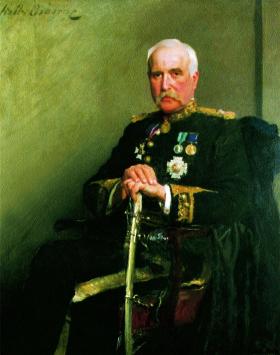
Portrait of Sir Andrew Reed by Walter Osborne. (Garda Museum and Archives)
Andrew Reed was born on 26 September 1837 in Galway town, the third of four children born to John and Mary (née Adamson) Reed. Andrew Reed’s father was a land agent, but Reed’s mother died three years after his birth and his father later remarried. Reed attended Dame School and Erasmus Smith’s school and was a bright pupil.
Early career
By the age of sixteen Reed was engaged in paid tutoring and in 1856 he won a scholarship to read law at Queen’s College, Galway. He was considering a career in the Indian civil service when the lord lieutenant, the earl of Carlisle, granted Queen’s a constabulary cadetship. Reed applied for the position, was accepted, and graduated as an LLB with gold medal in August 1859.
After successfully completing his constabulary entrance exam, Reed’s subsequent training at the constabulary depot was marked by swift progress, and he completed his exams two months ahead of schedule. Passing out of the Phoenix Park depot in December 1859, he was posted as a sub-inspector to Tipperary, where he resided in what he described as ‘poor lodgings in a small public house in Lorrha’. In May 1862 he was transferred to County Donegal and was posted to Dunfanaghy in July 1863. From the outset Reed was a talented policeman, and between August 1863 and May 1864 he accrued no less than four favourable records for excellent police work.
In July 1866 Reed found himself in the thick of the action in riot-stricken Belfast. The riots were occasioned by tensions caused by a combination of elections and the 12 July celebrations, and, to quote Reed, it was ‘very hard duty, and I and my men had often to take rest at night lying on the flagstones and doorsteps of the houses’.
The following year Reed married Elizabeth Mary Lyster of Croghan House, Parsonstown (Birr), King’s County (Offaly), and they moved to Leixlip, Co. Kildare. In October 1867 Reed was transferred back to Belfast, where he was placed in command of the north district. He found Belfast in ‘a continual state of excitement [and] it was sometimes very difficult to preserve the peace’. On the other hand, relations between the police and the mayor and magistracy were unusually cordial during this period, and when various disturbances occurred Reed and his men would often find cases of champagne delivered to the police station—gifts from the mayor and the local justices to the exhausted policemen.
Rewrote the policeman’s manual
Reed’s earlier service during the Belfast riots had been noted by the inspector-general of the day, Colonel John Stewart Wood, and when Wood’s private secretary died in November 1868 Reed replaced him. Reed ‘left Belfast with much regret’, but his installation at police headquarters was the beginning of his swift ascent of the promotional ladder. In comparison with the complexities of policing Belfast, Reed’s work at Dublin Castle was scarcely onerous and he put his spare and leisure hours to good use. It was an enormously productive time for him: he began to study law and in 1873 was called to the Irish bar.
Reed offered to revise The Constabulary Code, and this work he likened to ‘Penelope with the web, doing and undoing [as] the issue of fresh orders would upset much of my previous work’. He wrote The Irish Constable’s Guide and The Policeman’s Manual during this period. Both became standard works of reference and form the basis upon which Irish policemen conduct themselves today. The profits from his authorship of these works were directed to the queen’s jubilee fund for the RIC, for the relief of the needy orphans of members of the force. In his Irish Constable’s Guide Reed recommended strict sobriety for those policemen wanting ‘to succeed in the service’ and the issues arising from intemperance were of great interest to him. He subsequently produced a significant work entitled The Liquor Licensing Laws of Ireland and Innkeeper’s Guide.
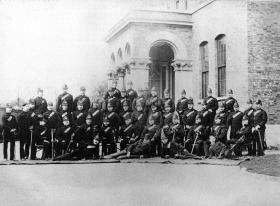
Group of officers photographed outside the officers’ mess, Phoenix Park, Dublin, 1885. Reed (in plumed hat) is seated in the middle of the photograph. (Royal Ulster Constabulary GC Museum)
Land War
Reed continued as private secretary to the inspector-general when Lieutenant Colonel George E. Hillier succeeded Stewart Wood on 19 September 1876. Reed was an able administrator, and his service on the depot staff resulted in his being raised some 25 steps up the RIC seniority ladder. In a force where promotional progress was absolutely glacial, this was indeed a meteoric rise. But in July 1879 he qualified as a county inspector and was then posted to Donegal, an area soon to be embroiled in the Land War. His work during this troubled phase of Irish history was both hazardous and arduous, and although Reed was a man of considerable intellectual abilities, he was also a practical policeman who invariably led from the front and in June 1880 he was injured on duty, although he evidently made a quick recovery. In June 1881 he was sent back to police headquarters to command the RIC’s crime division, whose remit was the prevention and detection of politically motivated crime. Reed’s appointment ensured that he had a significant input into the investigation of many of the notable crimes of the period: the Fenian bombing campaign, the Phoenix Park murders in May 1882 and the Maamtrasna massacre of the following August.
In March 1882 Reed submitted a memorandum to government on the resemblance of tactics between the ongoing no-rent agitation and the no-tithe agitation of 1831–2 and recommended that the Land League should be declared illegal by statute. It was his first major foray into the corridors of power, and this memorandum was to be followed by a number of memoranda and pamphlets designed to bring his views to government attention. It demonstrated the passion that he felt for all aspects of his job—it probably did not do his career any harm either. On 12 May 1882 Colonel Robert Bruce gained command of the RIC upon Hillier’s retirement and Andrew Reed became an assistant inspector-general. As a result of the deliberations in March 1883 of a committee (of which Reed was a member) tasked to reorganise the police and criminal administration in Ireland, the country was divided into six divisions. Each division was to have its own commissioner, and Andrew Reed was selected as commissioner and magistrate at Athlone with overall responsibility for the counties of Clare, Galway, Mayo and Roscommon. However, Reed’s position was short-lived; in August 1885 he was chosen for the post of inspector-general, and assumed office on 21 September 1885.
The reference books that Reed had written demonstrated that he was a man with a mission. In his address to the young constables in The Policeman’s Manual he made it clear that the police force he wished to create should be one that held to all the general principles of a professional civil police force, and woe betide any subordinates who did not subscribe to that mission. Whilst part of the police and criminal reorganisation committee, Reed recommended the abolition of the offices of inspector-general, deputy inspector-general and assistant inspector-general. A single chief commissioner and a subordinate inspecting commissioner solely responsible for police discipline would replace these. This was not just a cosmetic change in nomenclature—he wanted a ‘civilianised’ police force that was accountable. The proposals submitted on 9 March 1883 evidently did not meet with government approval, and as Reed did not have the rank to pursue these structural changes at that time they were shelved.
Reed had a finely developed political antenna, and henceforth as inspector-general the changes to his palimpsest would be both gradual and internal. Reed was the only inspector-general to have risen through the ranks without a military background, and his views on police discipline were illustrative of those civilian origins. He abolished punitive fines where a simple admonition would suffice, thus saving the career of many a good head constable and sergeant, and in all disciplinary matters he ensured that the punishment would fit the crime. The ultimate disciplinary sanction was dismissal from the force, and under Reed the dismissal rates were markedly and consistently reduced. He said that he ‘never regretted having to soften the rules of discipline’, and clearly this more humane approach was a notable departure for the RIC and wholly appropriate to Reed’s civil police ethos. Also in keeping with this philosophy was the notion that men of ability rather than seniority should prosper in his force, and to that end he encouraged the use of promotional exams.
Perhaps recalling his own public order duty, Reed was particularly solicitous of the welfare of non-commissioned policemen; however, other officers were not always so conscientious. In 1891 Reed publicly reminded all his officers that the welfare of the men under their command ‘should be their first consideration’. His non-commissioned subordinates responded with warmth and he was affectionately known as ‘their chief’. In his frequent inspections Reed meticulously noted the names and his observations of all the policemen he met, tabulated those noted and referred to them when necessary. In this way he built up an extensive knowledge of a great many men in his force—these men were not military myrmidons to Reed.
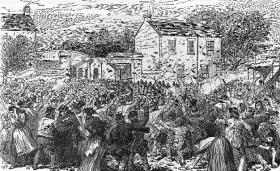
Belfast’s 1886 riots—Reed’s ‘most arduous and responsible duty’. (Illustrated London News, 21 August 1886)
Belfast’s 1886 riots
The true test of any military or semi-military disciplinary system comes when the lives of the men under that system are threatened, and, as always in the history of the constabulary, Belfast was to prove one of its greatest tests. The 1886 Belfast riots began on 3 June and lasted, with fitful pauses, until 21 September. The circumstances of the riots were outlined by the author in a previous article (‘Closely Akin to Actual Warfare: the Belfast riots of 1886 & the RIC’, HI 7.4, Winter 1999). Reed called the riots his ‘most arduous and responsible duty’, and that duty began on 7 August when he was dispatched to the town by the new chief secretary, Sir Michael Hicks Beach.
Staying at the Royal Hotel, Reed had little time to enjoy its comforts, and throughout his time in Belfast he was to be seen, mounted or dismounted, amongst his policemen in the cobbled streets, often until the early hours of the morning. In one report to the under-secretary Reed apologised for the ‘crude report’ (his writing is appalling!), but he begrudged spending time writing because he believed that he was ‘best employed directing his work’. He suggested that a small executive committee should be formed, which should include the mayor, military and police commanders, stipendiary magistrates ‘and some of the ordinary justices representing both political parties, so that the public might have confidence in the committee’. This committee replaced the unwieldy general committee that had met thus far, and Reed’s initiative served to reunite what had become a very divided authority.
Reed was clearly uncomfortable with the notion of the RIC as a semi-military body; it was a cornerstone of his belief in the efficacy of civil policing that if it was necessary to fire on rioters the army should be the only ones to do so, but if the police had to be armed and had to use their weapons he maintained that they should do so with effect. To do otherwise, he argued, was counterproductive, and firing over the heads of a crowd invariably injured the innocent bystander. With his personal experience of past Belfast riots, Reed was aware, as he put it, that ‘so long as the mob are in possession of rifles the police cannot be left without them’, but he never made any secret of the fact that he believed that the police should dispense with their arms ‘if the banditti in Belfast give up their rifles permanently’. Several people, some of whom were entirely innocent, had already succumbed to police rifle fire, and Reed proposed to the military commander, Major General Montgomery Moore, that in future the RIC should only accompany the military armed with truncheons. Moore refused and a tactful Reed did not feel disposed to pursue the issue. However, concerned at the level of civilian casualties, Reed reaffirmed the fifty–fifty mix of riflemen and baton men and enjoined his constables to use only buckshot in their rifles and not to fire upon people whilst defending private property.
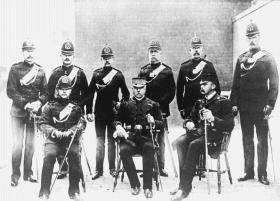
Reed (seated centre) with senior officers at Musgrave Street station, Belfast, 1900. (Royal Ulster Constabulary GC Museum)
Policing the Shankill
It is quite possible that Reed’s intervention was decisive; in any event, the rioting decreased in intensity after the blood-letting that took place on 7 and 8 August. However, the police had completely withdrawn from the Shankill and their reinsertion was an absolute prerequisite for a return to normality. Dublin Castle deprecated the decision to withdraw, but Reed maintained that he knew nothing of this decision until it occurred. That may well be true, but he later admitted ‘the great advantages tending towards a permanent peace’ that were occasioned by the RIC withdrawal.
One of the notable features of the 1886 riots was the support given to the rioters by what were then described as ‘respectable people’. Both in an active sense and in the measure of legitimacy afforded the rioters, shopkeepers, their assistants and people of their ilk set their face against the RIC in the 45 streets that fed into the Shankill. Reed was faced with a dilemma. Should he force the police upon the inhabitants, if necessary, as one of his predecessors advised, ‘shoot[ing] down all who opposed the law’? Or was he to wait until he could effect ‘the recovery of the moral support of the law-abiding people’? Reed wisely chose the latter course and delayed the full restoration of the constabulary until 1 September. By that time more than one shopkeeper in the area had suffered the violent depredations of the ‘roughs and corner boys’, and both the clerical and lay leaders of the Shankill had calmed their rhetoric sufficiently to allow moderation and the rule of law to prevail. The return of the RIC to the Shankill did not mark the end of the 1886 riots, but it did mark an end to the worst of the Protestant opposition to the police.
Criticism of Reed’s role in the riots
Neither Reed nor the constabulary came out of the Belfast débâcle well. Undoubtedly the police were ‘subjected to almost unparalled trials’, but mistakes were made; and although both Reed and the commission of inquiry placed much emphasis on the role of politicians and clergymen in fomenting the riots, neither Reed nor his force could be absolved of blame for their continuance. It is true that Reed’s project to civilianise the force had little time to take effect, and there is no doubt that as a result the force was working in a situation where on occasions it was too military for the task and on others not military enough, but there was more than one instance of firing without orders and more than one instance when a rioter should have been arrested rather than beaten or shot at. But most of the RIC’s failings in 1886 were structural and tactical.
Reed’s late arrival in Belfast was a mistake. His memoirs show that previous inspectors-general had swiftly attended Belfast’s riots when they became serious. Reed knew very well that Belfast was a powder-keg, both from his own past experience and from the prevailing political climate; given this, his absence when the riots became serious in June/July is mystifying. Further, he should have instituted a police inquiry after the Bowershill police shooting of 8 June. This would have defused some of the problems that subsequently arose. In view of Reed’s poor opinion of the Irish press, it was also a mistake to allow the rumour to circulate freely that the chief secretary was bringing in Catholic policemen to quash Protestant dissent over the Home Rule issue. This was a complete fabrication and Reed should have made it clear and stressed his own operational independence sooner. During the riots there were nine separate changes of police commander. Although exhaustion and stress were obviously factors, such frequent replacement of pivotal figures in Belfast was scarcely conducive to effective riot containment—and these changes were always subject to Reed’s approval. The riots commissioners aired most of these criticisms, but chose not to hold Reed personally responsible for police failings. Reed’s own bravery in 1886 cannot be questioned, but his judgement on occasions can.
However, Reed’s lapses were ones of omission rather than commission and, despite Arthur J. Balfour’s later veiled criticism of the police role in the Belfast imbroglio, Reed’s actions received fulsome praise in the very public forum of the House of Commons. On 1 September Sir Michael Hicks Beach remarked:
‘Since I sent the inspector-general of constabulary to Belfast to reunite a very divided authority we have reaped the greatest benefit from his action, from the tact he has displayed, and from the judgement and common sense which he has infused into the management of affairs. I wish to express, on the part of the government, our obligation to the inspector-general for the manner in which he has performed his work.’
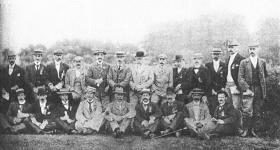
Some members of the RIC depot sports club, committee and friends, August 1898. Reed is standing in the centre wearing a bowler hat. (Royal Ulster Constabulary GC Museum)
Despite there being more Belfast riots whilst Reed held the supreme office, most notably in 1896 and 1898, neither Reed nor his force repeated their mistakes, and although Victorian Belfast was never exactly quiescent it did not suffer the level of bloodshed of 1886 again.
In a profile of Reed written in 1892, The Dublin Figaro remarked that Reed had ‘always been fortunate . . . to keep on good terms, with friend and foe alike’. This is undoubtedly true, as criticisms of Reed both during his lifetime and after his death have been muted—unusual, considering his prominence during such exceptionally trying times. Nevertheless, Arthur Balfour privately disliked Reed because he suspected that Reed hid the more flagrant examples of RIC ill-discipline from him. This may be an accurate assessment of Reed; he was fiercely protective of his force. However, checking Balfour’s assertion is virtually impossible, given the neglectful and deliberate destruction of RIC personnel records that began in 1939. Similarly a charge that Reed intimidated witnesses to ensure the ‘correct’ verdict at the Maamtrasna enquiry may equally be true. But again, verification of this accusation would rely on the barest of source material somewhat devoid of hard evidence. This is not to say that Reed was faultless, but the general perception of Reed as a man of genuine vision and ability has, given the available evidence, more to recommend it than one of Reed as a manipulative schemer.
Reed continued as inspector-general until August 1900, when he retired, to be replaced by the urbane Sir Neville Chamberlain. Having garnered a knighthood, KCB and CVO during his tenancy of the post, Reed could afford to rest on his considerable laurels. He travelled extensively during his latter years, was involved in a good deal of philanthropic work and was elected to a governorship of the Erasmus Smith board. On 7 November 1914, after an illness lasting less than a week, Reed died and, following a private funeral, was buried at Deansgrange cemetery, Dublin.
Described by one of his contemporaries as a ‘man with an infinite amount of sterling ability and tact’ and by recent historians as ‘avuncular’, ‘affable and approachable’, Reed seems to have amounted to all those things. But despite this, and despite his occasional lapses of judgement, Andrew Reed was actually rather more than just a well-mannered and able policeman: he was one of the pivotal figures in Irish police history. Until very recently his portrait by Walter Osborne occupied pride of place at the Garda Museum. Doubtless Reed would have approved—a very civil policeman, amidst the memorabilia of Ireland’s first civil police force.
Mark Radford is a freelance researcher specialising in contemporary Irish history.
Further reading:
A. Boyd, Holy war in Belfast (Tralee, 1969).
S. Breathnach, The Irish police: from earliest times to the present day (Dublin, 1974).
C.S. Nicholls (ed.), The Dictionary of National Biography: Missing Persons (Oxford, 1994).
















